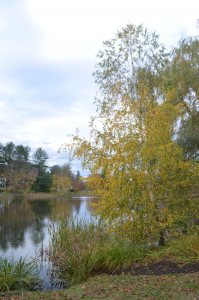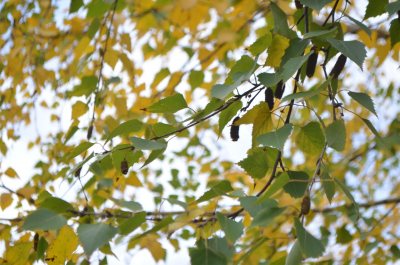Gray Birch
Betula populifolia| Family: Betulaceae
Submission: Kawai Marin ‘18
Gray birch (Betula populifolia), otherwise known as “old field birch,” is an incredibly short-lived species. These trees are an iconic aspect of the American pastoral, often taking root among vast open fields, woodland edges, and other disturbed sites. This tree gets its Latin name from its quaking leaves, an unusual characteristic among birches, and almost exclusively unique to a different family of trees, the poplars. Consequently, when translated directly from Latin to English, Betula populifolia means “birch with poplar-like leaves.” Their gray/white chalky bark is reminiscent of their ecological counterpart, the paper birch. The two are oftentimes confused, but unlike the paper birch, the gray birch has a trunk that does not extensively shed or peel its bark. Rarely growing above forty feet tall, gray birch thrive in cooler, more temperate regions such as the Northeastern U.S. and Southeastern Canada.
Gray birch wood is as delicate as the nostalgic memories it evokes. Prior to the arrival of European settlers, gray birch was held in high esteem by many Native American tribes. The Iroquois and Mi’kmaq tribes valued gray birch for its medicinal properties for treating infected cuts and wounds. Today, the incredibly light, soft, and oftentimes coarsely-grained wood is used primarily for pulp, furniture, and more frequently, firewood. Beyond these uses, the soft wood is apt to decay very rapidly when exposed to the elements, rendering gray birch wood with little commercial value. Nevertheless, its true value is not found on the market but rather in the very fields where it takes root. To behold such a tree in its wild splendor is a gift indeed. As the English poet William Blake once wrote, “A fool sees not the same tree a wise man sees.”
Leaves – Doubly serrate; deltoid; acuminate tip.
Twigs – Slender, with warty lenticels; non-aromatic; buds ovoid, gummy.
Fruit – Cylindrical, spreading or ascending, deciduous.
Bark – Dull; gray to chalk white; thin, tight, black patches below branches.
Silvics – Small, intolerant pioneer tree common on infertile sites; native from easter Canada south to Delaware; smallest of northeastern birches.
References:
Brand, H. Mark. University of Connecticut Plant Database, http://hort.uconn.edu/plants, Department of Plant Science and Landscape Architecture, Storrs, CT 06269-4067 USA Acessed October 29th, 2017.
Brockman, C.F. 1986. Trees of North America: A Guide to Field Identification. Revised Edition. Western Pub. Co., Inc. 280pp.
Elias, T.S. 1980. The Complete Trees of North America Field Guide and Natural History. Van Nostrand Reinhold Co., N.Y. 948pp.
Harlow, W.M., Harrar, E.S., Hardin, J.W. and White, F.M. 1991. Textbook of Dendrology. McGraw-Hill Inc., N.Y. 501pp.
Petrides, G.A. 1972. A Field Guide to Trees and Shrubs. 2nd edition. Houghton Mifflin Co., Boston. 428pp.
Preston, R.J., Jr. 1989. North American Trees. 4th edition. Iowa State Univ. Press. Ames. 407pp.
Moerman, E. Daniel. Medicinal Plants of Native America, Part 1. Museum of Anthropology, University of Michigan, 1986.

